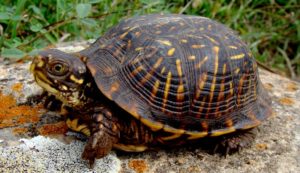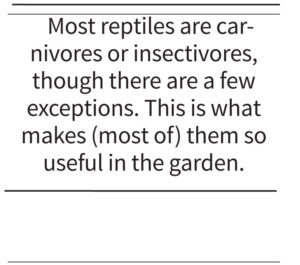Your Garden … with Kate Russell: Reptiles and amphibians keep bugs down in your Gilroy garden
Since reptiles are mostly shy, conflicts are rare

By Kate Russell
You may see a lizard scurrying for cover under your lettuces, or a snake slithering across your strawberry patch, but what are they doing in your garden? Are they pests or helpers? What’s the difference between reptiles and amphibians?
Reptiles and amphibians are both cold-blooded. If you want to attract them to your Gilroy garden, this is helpful information. The difference between reptiles and amphibians is seen in their skin. Reptiles have dry, scaly skin, while amphibians have smooth, moist skin. Also, amphibians start their lives in water, breathing through gills, while reptiles do not.
The reptile clan includes lizards, snakes, and turtles. Most reptiles hatch from eggs, while some give live birth. Reptiles shed their skin as they grow, so you may find signs of a resident lizard, even if it is too shy to let you catch it out in the open.
 Most reptiles are carnivores or insectivores, though there are a few exceptions. This is what makes (most of) them so useful in the garden. Local reptiles will feed on aphids, ants, beetles, flies, wasps, grasshoppers, slugs and snails, smaller reptiles, baby voles, mice, and rats, sowbugs, earwigs, and practically anything else they can grab, including beneficial spiders and worms.
Most reptiles are carnivores or insectivores, though there are a few exceptions. This is what makes (most of) them so useful in the garden. Local reptiles will feed on aphids, ants, beetles, flies, wasps, grasshoppers, slugs and snails, smaller reptiles, baby voles, mice, and rats, sowbugs, earwigs, and practically anything else they can grab, including beneficial spiders and worms.
Creating habitat for native reptiles in or near your garden is an easy way to limit pest populations without chemicals or effort on your part. Just be sure you do not release an invasive pet reptile into your yard — it is against the law and can lead to serious problems. In California, native lizards may not be captured or sold, so you can’t buy them. What you can do is create a welcoming habitat. Sooner or later, they will find it.
To attract reptiles, install native grasses, ground covers, and nectar or berry producing plants; mulch; leave leaf litter on the ground; allow vines or creepers to grow up fences; provide a variety of sun and shade; provide rocks, logs, and large pieces of bark as hiding and sunning locations; provide fresh, clean water in a protected spot; avoid using chemical fertilizers, pesticides, and snail bait; and keep cats indoors.
Nearly all reptiles in Gilroy are harmless, with the exception of rattlesnakes, Mexican bearded lizards, gila monsters, and a handful of others. Since reptiles are mostly shy, conflicts are rare. Creating habitat for these elusive garden helpers is a wonderful way to cut back on your workload, while increasing biodiversity in your garden.
Kate Russell is a UCCE Master Gardener in Santa Clara County. For more information, visit mgsantaclara.ucanr.edu or call (408) 282-3105 between 9:30 a.m. and 12:30 p.m., Monday through Friday.
- Your Garden . . . with Kate Russell: Plant your garden according to watering needs, known as hydrozoning - August 12, 2021
- Your Garden . . . with Kate Russell: Trade in your lawn for a meadow and reduce maintenance chores - July 15, 2021
- Your Garden . . . with Kate Russell: The right soil chemistry balance will go a long way for healthy plants - June 17, 2021
